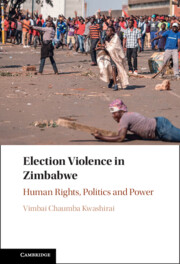Book contents
- Election Violence in Zimbabwe
- Election Violence in Zimbabwe
- Copyright page
- Dedication
- Contents
- Figures
- Tables
- Preface
- Acknowledgements
- Abbreviations
- Introduction
- 1 Violence, a Colonial Curse
- 2 Zanu PF and PF Zapu Violence
- 3 The New Enemy in the 1990 General Elections Was Zum
- 4 Zanu PF on Zanu PF Violence in 1995
- 5 What Presidential Election in 1996?
- 6 The Movement for Democratic Change Was Number One Enemy in 2000
- 7 Presidential Election in 2002
- 8 What General Elections in 2005?
- 9 Disharmony in the 2008 Harmonised Elections
- 10 Violence in the 2013 Elections
- Conclusions
- Recommendations
- Select References
- Index
7 - Presidential Election in 2002
Published online by Cambridge University Press: 23 February 2023
- Election Violence in Zimbabwe
- Election Violence in Zimbabwe
- Copyright page
- Dedication
- Contents
- Figures
- Tables
- Preface
- Acknowledgements
- Abbreviations
- Introduction
- 1 Violence, a Colonial Curse
- 2 Zanu PF and PF Zapu Violence
- 3 The New Enemy in the 1990 General Elections Was Zum
- 4 Zanu PF on Zanu PF Violence in 1995
- 5 What Presidential Election in 1996?
- 6 The Movement for Democratic Change Was Number One Enemy in 2000
- 7 Presidential Election in 2002
- 8 What General Elections in 2005?
- 9 Disharmony in the 2008 Harmonised Elections
- 10 Violence in the 2013 Elections
- Conclusions
- Recommendations
- Select References
- Index
Summary
Zimbabwe’s longest election season span from the February 2000 referendum to the 2002 presidential election. In 2002, voters became wary and weary of violent elections. Politically motivated violence continued as Mugabe and Tsvangirai had their moment of reckoning as to who should be president of Zimbabwe. Over time, Mugabe become ever more dependent on violence and dictatorial methods, and less and less interested in the welfare of his people, treating Zimbabwe’s wealth and resources as rewards for loyal Zanu PF supporters, boasting that there was no vacancy at State House. A closer study of the incidence of election violence shows voter resilience amidst cyclical bouts of state-sponsored udlakela. Voter resilience in the ruling party and opposition showed the potential and capability of the electorate to recover from crises and shocks. Zimbabwe voter resilience revealed that no matter the number of violent disturbances Zimbabweans absorbed over time, they remained within a relatively similar political state domain without imploding. Voters in Zimbabwe were remarkably resilient, displaying abilities of self-organization under extreme periodic election stresses. They built capacity and adaptation in the face of election adversities without resorting to civil war.
Keywords
- Type
- Chapter
- Information
- Election Violence in ZimbabweHuman Rights, Politics and Power, pp. 159 - 183Publisher: Cambridge University PressPrint publication year: 2023

